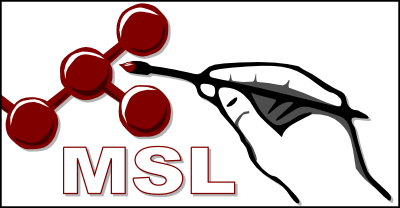Difference between revisions of "Main Page"
(→Main development team:) |
|||
| Line 45: | Line 45: | ||
* Brett Hannigan, U. of Pennsylvania, Genomics and Computational Biology Graduate Group | * Brett Hannigan, U. of Pennsylvania, Genomics and Computational Biology Graduate Group | ||
* Gevorg Grigoryan, Dept. of Computer Science, Dartmouth College, Hanover NH, [http://www.cs.dartmouth.edu/~gevorg/ '''Grigoryan Lab'''] | * Gevorg Grigoryan, Dept. of Computer Science, Dartmouth College, Hanover NH, [http://www.cs.dartmouth.edu/~gevorg/ '''Grigoryan Lab'''] | ||
| − | |||
| − | |||
=== Reference === | === Reference === | ||
Revision as of 15:31, 26 April 2013
Contents
MSL: an open source C++ library for analysis, manipulation, modeling and design of macromolecules.
Philosophy
The main goal is to create a set of tools that enable the computational study of macromolecules with relative ease at all levels, from simple operations (for example, load a PDB and measure a distance or edit a dihedral) to complex applications (protein modeling or design).
The MSL library is not a program (although some applications are distributed) but a tool for scientist to code their own methods.
Features
Some of the features supported by the library are:
- Support for reading and writing PDB and CRD files.
- The ability of storing and switching between multiple atom coordinates, for conformational changes and rotameric representation of side chain conformational freedom.
- For protein design, the ability to build and store multiple residue identities (i.e. LEU, ILE, ALA) at a position and switch between them.
- Support for rotamer libraries.
- Transformations such as translations, rotations, and alignments.
- The CHARMM force field and other energy funtions.
- Support for CHARMM topology and parameter files.
- Structure building from scratch (using internal coordinates)
- Search algorithms such as Monte Carlo, Dead End Elimination, and Self Consistent Mean Field Monte Carlo.
- Local backbone sampling.
- Crystal lattice generation.
- A PyMOL Python Interface for calling MSL code from within PyMOL.
- A R Interface for calling arbitrary R algorithms or plotting routines from within MSL
- And more...
Documentation
The Documentation – currently still under construction – provides a description of the objects and of some distrubuted programs and utilites. A step by step tutorial is being assembled.
Status
Current version: 1.1, released on April 3, 2013.
Previous versions: 1.0, released on July 8, 2012.
Source
The source code can be downloaded on SourceForge. Go to the Download page. ("To do" list).
Main development team:
- Alessandro Senes, Sabareesh Subraminiam, Ben Mueller, Dept. of Biochemistry, U. of Wisconsin-Madison, Senes Lab
- Dan Kulp, IAVI, Scripps Research Institute, La Jolla CA
- Jason Donald, Agrivida, Inc., Medford MA
- Brett Hannigan, U. of Pennsylvania, Genomics and Computational Biology Graduate Group
- Gevorg Grigoryan, Dept. of Computer Science, Dartmouth College, Hanover NH, Grigoryan Lab
Reference
Article published using MSL should cite:
MSL (including early versions) has been used in the following work:
Loren M LaPointe, Keenan C Taylor, Sabareesh Subramaniam, Ambalika Khadria, Ivan Rayment, Alessandro Senes
Structural organization of FtsB, a transmembrane protein of the bacterial divisome.
Biochemistry: 2013, 52(15);2574-85
[PubMed:23520975]
##WORLDCAT## [DOI]
(I p)
Jian Zhang, Gevorg Grigoryan
Mining tertiary structural motifs for assessment of designability.
Methods Enzymol: 2013, 523;21-40
[PubMed:23422424]
##WORLDCAT## [DOI]
(I p)
Amanda J Reig, Marcos M Pires, Rae Ana Snyder, Yibing Wu, Hyunil Jo, Daniel W Kulp, Susan E Butch, Jennifer R Calhoun, Thomas Szyperski, Edward I Solomon, William F DeGrado
Alteration of the oxygen-dependent reactivity of de novo Due Ferri proteins.
Nat Chem: 2012, 4(11);900-6
[PubMed:23089864]
##WORLDCAT## [DOI]
(I p)
Sabareesh Subramaniam, Alessandro Senes
An energy-based conformer library for side chain optimization: improved prediction and adjustable sampling.
Proteins: 2012, 80(9);2218-34
[PubMed:22576292]
##WORLDCAT## [DOI]
(I p)
Yong Ho Kim, Jason E Donald, Gevorg Grigoryan, George P Leser, Alexander Y Fadeev, Robert A Lamb, William F DeGrado
Capture and imaging of a prehairpin fusion intermediate of the paramyxovirus PIV5.
Proc Natl Acad Sci U S A: 2011, 108(52);20992-7
[PubMed:22178759]
##WORLDCAT## [DOI]
(I p)
Ivan V Korendovych, Daniel W Kulp, Yibing Wu, Hong Cheng, Heinrich Roder, William F DeGrado
Design of a switchable eliminase.
Proc Natl Acad Sci U S A: 2011, 108(17);6823-7
[PubMed:21482808]
##WORLDCAT## [DOI]
(I p)
Jason E Donald, Yao Zhang, Giacomo Fiorin, Vincenzo Carnevale, David R Slochower, Feng Gai, Michael L Klein, William F DeGrado
Transmembrane orientation and possible role of the fusogenic peptide from parainfluenza virus 5 (PIV5) in promoting fusion.
Proc Natl Acad Sci U S A: 2011, 108(10);3958-63
[PubMed:21321234]
##WORLDCAT## [DOI]
(I p)
Jason E Donald, Daniel W Kulp, William F DeGrado
Salt bridges: geometrically specific, designable interactions.
Proteins: 2011, 79(3);898-915
[PubMed:21287621]
##WORLDCAT## [DOI]
(I p)
Ivan V Korendovych, Alessandro Senes, Yong Ho Kim, James D Lear, H Christopher Fry, Michael J Therien, J Kent Blasie, F Ann Walker, William F Degrado
De novo design and molecular assembly of a transmembrane diporphyrin-binding protein complex.
J Am Chem Soc: 2010, 132(44);15516-8
[PubMed:20945900]
##WORLDCAT## [DOI]
(I p)
Bryan W Berger, Daniel W Kulp, Lisa M Span, Jessica L DeGrado, Paul C Billings, Alessandro Senes, Joel S Bennett, William F DeGrado
Consensus motif for integrin transmembrane helix association.
Proc Natl Acad Sci U S A: 2010, 107(2);703-8
[PubMed:20080739]
##WORLDCAT## [DOI]
(I p)
Yao Zhang, Daniel W Kulp, James D Lear, William F DeGrado
Experimental and computational evaluation of forces directing the association of transmembrane helices.
J Am Chem Soc: 2009, 131(32);11341-3
[PubMed:19722646]
##WORLDCAT## [DOI]
(I p)
